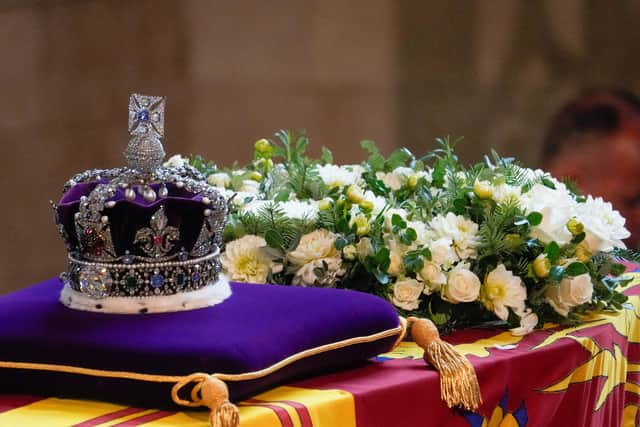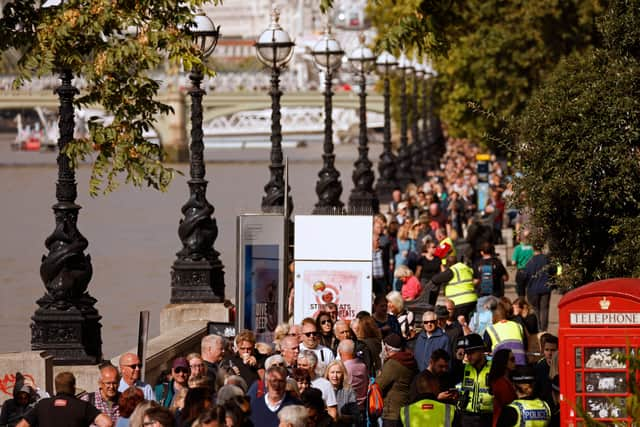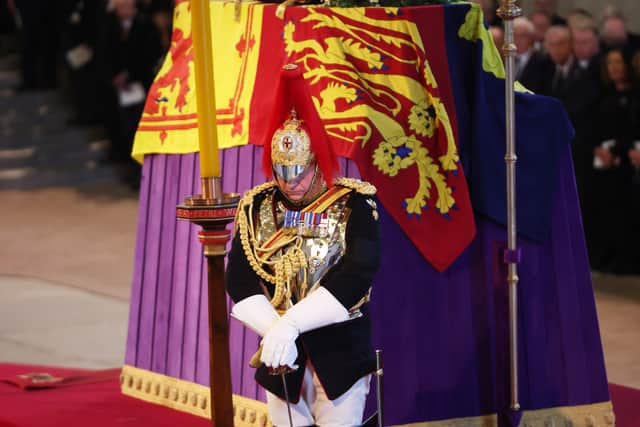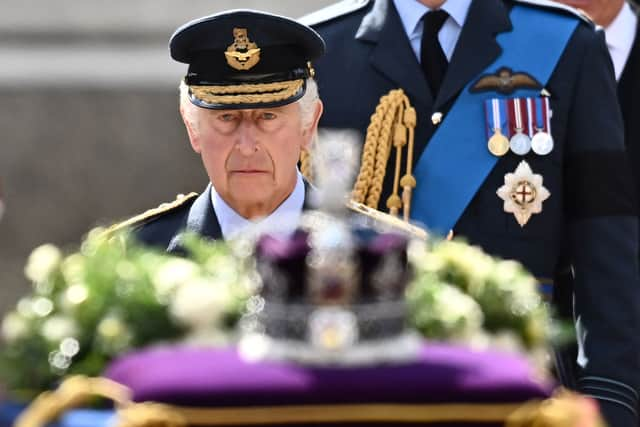Plush carpet, medieval power and camping stools: Inside the Queen’s lying-in-state
and live on Freeview channel 276
The hush is the first thing you notice.
Steps are muffled by the thick carpet laid across the stone floor. Voices are silenced, and sobs choked back.
The scent of a rich perfume or almost incense-like smell drifts in the air.
Advertisement
Hide AdAdvertisement
Hide AdVast wooden arches stand above you while an imposing stained glass window, almost as tall as the ancient walls themselves, glitters and refracts the light through dozens of rainbow panes of glass.
In front of you, the Queen’s coffin.


Standing atop a red velvet platform and draped with the nation’s flag, she is guarded by an ever-changing parade of soldiers, sombre faced and motionless.
It’s everything I imagined and expected it would be - and also, not.
The physical sensation of power, and grandeur, in the room is unmistakable.
Advertisement
Hide AdAdvertisement
Hide AdFinely tuned, and well-oiled, the wheels of the British state have sprung into motion - corralling the multitudes of visitors, erecting barriers, dishing out water, signposting toilets.
The monarchy’s soft power - headlines praising the Queen’s undeniably impeccable decades of service, cheering crowds greeting now-King Charles - has been out in full force.


But it’s a rare occasion, here in the UK, in the 21st century, that the ordinary among us find ourselves confronted so bluntly with the raw instruments of that power.
Men with swords, surrounding a gilded coffin.
If it sounds medieval, you only need to look around.
And throughout the grand room are the endless lines of mourners.
Advertisement
Hide AdAdvertisement
Hide AdDressed in black suits, immaculate shirts and ties, bundled in winter coats and scarves, in T-shirts and jeans, tracksuits, buggies, wheelchairs.


Carrying bags, jackets, walking sticks, tissues, and babies, they have come - from, we must assume, practically the four corners of the earth.
I’m most impressed by the ones who have managed to dodge all, clearly stated, rules to the contrary and smuggle in camping stools under their arms. Rebels.
And cheered by those, who among the sea of muted colours, have chosen a hot pink scarf, a shining display of medals, or in perhaps my favourite tribute, a neon Pop-Art Elizabeth, emblazoned postage-stamp style across a top.
It’s almost impossible not to find the line mesmerising.
Advertisement
Hide AdAdvertisement
Hide AdIts steady progress is a hypnotic drift across the hall. Some cry, some salute, others curtsy, cross themselves, or just stare blankly.


Above all though, I’m desperate to ask them, why?
For myself, and the other journalists in the elevated press viewing box, it’s a sense of professional - and lifelong personal - curiosity.
Of the crowd, we can assume that a certain proportion - perhaps a third or close to a half - are simply enthusiastic participants in history.
The same group who bid for tickets to obscure Olympic 2012 sports and lined the Mall for the Platinum Jubilee parade.
Advertisement
Hide AdAdvertisement
Hide AdOthers perhaps have a familial or personal connection to the Queen herself in some way.


An oath sworn in a military career, an aunt or uncle who worked for the Palace.
Or even a chance meeting with a sensibly clad octogenarian on a Norfolk or Scottish country walk.
But it’s the third group in this self-selecting audience of the bereaved I’m most fascinated by.
Advertisement
Hide AdAdvertisement
Hide AdThose for whom, today, are rock lovers at the grave of Freddie Mercury, or football fans grieving their Maradona.
And their solemnity, emotion, and visible awe is somehow moving.
Ultimately, at the heart of all this, amid the pomp and circumstance, the dignitaries, the countless hours of civil service overtime, the media scrums and the plush carpeting, is a family.
And the fact that a loss at any age, nevermind how great a life lived, is still that.
Advertisement
Hide AdAdvertisement
Hide AdBut, impossibly, the Queen still manages to be and to represent all of this.
Splintered and refracted like the sunlight shining through the vast windows of Westminster Hall, her image, her role, her life, appeared differently to all of us.
Something imperceptible shifted with her death, and witnessing the profound impact on so many was a moment to remember.
Comment Guidelines
National World encourages reader discussion on our stories. User feedback, insights and back-and-forth exchanges add a rich layer of context to reporting. Please review our Community Guidelines before commenting.
